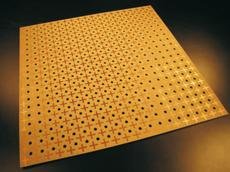Sep 8 2010
Researchers from ETH Zurich's Institute for Field Theory and High Frequency Electronics have developed new surfaces for radar absorption. Thanks to this multifaceted application, window panes could even double up as solar panels in future.
Surfaces that absorb radar radiation are used to camouflage military aircraft, ships and buildings. They may also be used to suppress undesired reflections in antenna measurement rooms and of buildings near airports, which would disturb airport radar systems. Preferably made of flat materials, most of them have the drawback of only capturing a narrow range of radar radiation. However, Christian Hafner, a professor at ETH Zurich and his team have now devised a new method to produce surfaces that can absorb radar radiation over an extremely broad range. Moreover, only being a few millimetres thick, the perforated plates are cheap and easy to make.
 The new metamaterials are particularly efficient at absorbing radar radiation through a recurring pattern of copper plates and holes (photo: Arya Fallahi / ETH Zurich).
The new metamaterials are particularly efficient at absorbing radar radiation through a recurring pattern of copper plates and holes (photo: Arya Fallahi / ETH Zurich).
Combination of antennae and holes
For their breakthrough, the researchers combined various components to form a so-called “metamaterial”. A commercially available, radar-absorbing substrate served as the base material, which they coated in copper geometric structures – in one case in the shape of little Swiss crosses. Patterns like this are known as frequency-selective surfaces as they act like little antennae, which resonate certain frequencies. Near resonance frequencies, they attract much field that is the absorbed in the substrate. The researchers combined the copper patterns with millimetre-sized round holes in the surface, which leads to additional resonances as in so called photonic crystals and further improves the absorption.
The important thing is that the size of the structures used corresponds to that of the wavelengths – a few millimetres in the case of radar radiation. Only then are resonances formed that amplify the signal. The more resonances there are, the more effectively the radiation is ultimately absorbed by the base material. By combining frequency surfaces with holes forming a photonic crystal several resonances could be created without increasing the absorber size.
The arrangement is what counts
It’s not only the size and shape of the copper structures and holes that are important for the ideal resonance effect but also their arrangement and position. Combinations of different patterns create resonances that interact and interfere with each other. “Interactions of this kind cannot be predicted intuitively”, explains Christian Hafner. To solve the problem, Arya Fallahi, who recently completed his doctoral thesis in Hafner’s group, has developed new software. It calculates which structure combinations achieve an optimal effect. “The aim was to create metamaterials with specific properties using the computer programme, which is relatively straightforward with radar waves. However, radar absorbers are only a stepping stone for more advanced applications”, says Hafner.
Window panes as solar panels
There are many potential uses for the new metamaterials; they can be adapted to other forms of radiation, such as infrared or solar radiation; and in a modified form, they could be used as a heat shield for turbines or for space travel. However, the structures have to be miniaturised before they can capture solar radiation. The spectrum of sunlight is nanoscale and the wavelength several thousand times smaller than with radar radiation. Consequently, the corresponding metamaterials also need to be nano-structured, which requires more sophisticated technology than for radar and micro-waves.
According to Hafner, it remains to be seen what developments will follow in the solar industry over the next few years. He envisages the use of metamaterials with electronically controllable properties, which could be used for intelligent windows. Window panes covered in them would work like blinds: when it’s overcast, they’d let light in; and when closed, they’d absorb sunlight and use it to generate power.